Roughly 35% of our happiness is circumstantial. This is 3.5 times as much as what is commonly believed from a 2005 study. In other words, 35% of our happiness is influenced by things that are not directly within our control.
A survey of 1,155 respondents found that on average, people say that 36% of our happiness is dependent on circumstances.
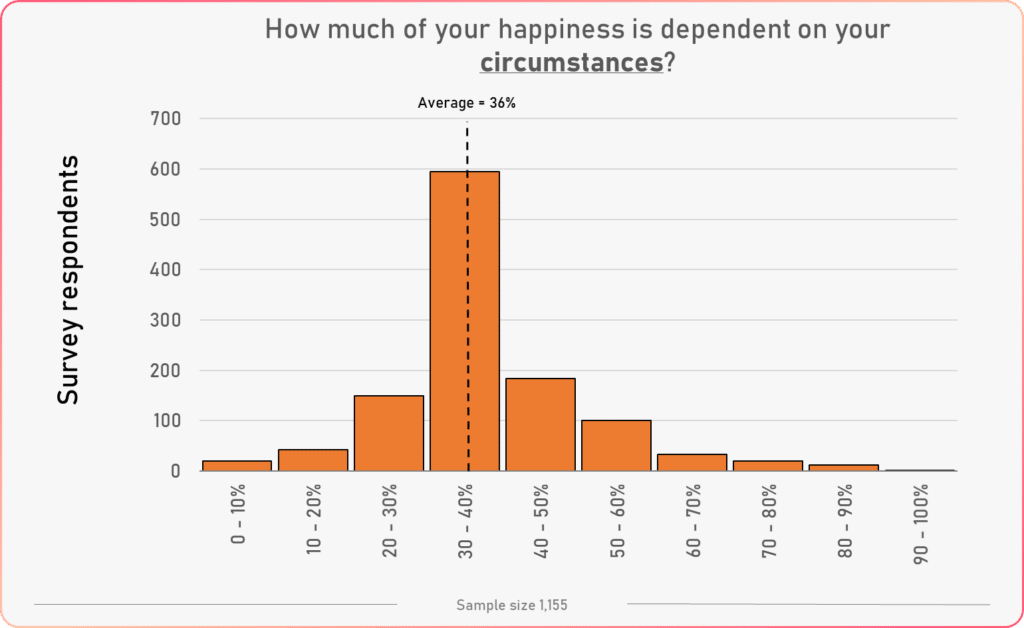
Some people think that happiness is not dependent on circumstances at all, while others think that happiness is 100% a result of our circumstances. The topic of circumstantial happiness contains a lot of polarizing opinions, however, there are not a lot of studies specifically targeting this theme.
Our study dives into the questions that circle around this subject. How much of our happiness is circumstantial? What type of people are inclined to think that happiness is circumstantial? What can we learn from their answers?
How much of our happiness is circumstantial?
Our survey questioned 1,155 respondents on their happiness, by asking a very specific question:
If you look back at the last year of your life, how much of your happiness was dependent on genetics, circumstances and your internal state of mind?
Each of the 1,155 respondents provided answers based on a range from 0 to 100%, with intervals of 10%.

(A footnote was added that reminded respondents that the total of all 3 factors must add to 100%. When the total didn’t match 100%, the individual factors were scaled up or down pro-rato, so that the total would match 100%.)
The 1,155 answers are presented in a histogram below:

The histogram shows a normal distribution, with an average of 36% and a standard deviation of 13%.
This means that the remaining 64% of our happiness is determined by either our genetics or our internal state of mind, according to the respondents.
What makes happiness more circumstantial?
With a standard deviation of 13%, we wanted to determine if there were certain factors that could reliably influence the amount of happiness that is determined by our circumstances. For example, does our marital status influence this 36% positively or negatively?
To find out, we asked each respondent a number of additional questions, ranging from overall happiness rating to employment status. How did these affect the amount of happiness that is circumstantial?
Happiness rating
The happiness rating of the respondents had a significant influence on the amount of circumstantial happiness they experienced.
We asked the respondents the following question about their happiness:
If you look back at the last year of your life, how would you rate your happiness on a scale from 1 to 10?
We then grouped all respondents based on their answers. Finally, we averaged their percentage of happiness that is determined by circumstances.
The results are shown in this graph:
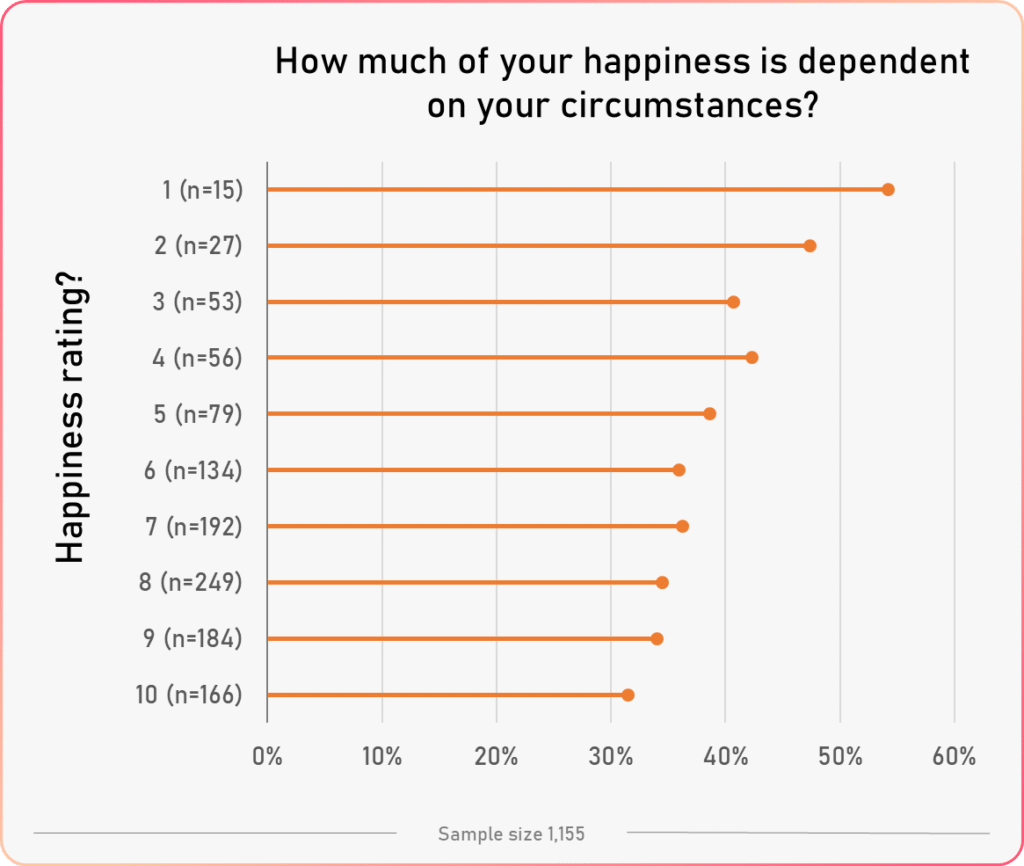
This shows that the happiest people in our dataset (happiness rating = 10) believe that only 31% of their happiness is circumstantial. On the other hand, the unhappiest respondents (happiness rating = 1) believe that more than half of their happiness (53%) is circumstantial.
This observation is in line with other findings. People who believe happiness can be controlled are 32% happier on average. Similarly, people that believe their happiness is more circumstantial (or out of their control) are significantly less happy.
This suggests that the more circumstantial our happiness is, the less happy we are.
This finding could be a result of the self-serving bias. The self-serving bias is the habit of a person taking credit for positive events or outcomes, but blaming outside factors for negative events. Unhappy people are therefore more inclined to blame outside factors, or external circumstances.
Can happiness be controlled?
People who believe that happiness is controllable are also inclined to think that a smaller part of their happiness is circumstantial.
We asked the respondents the following question about their happiness:
Is happiness something that you can control?
130 respondents answered “No”, while 1,025 respondents answered “Yes”. For each group, we averaged the percentage that they answered.
The results are shown in this graph:
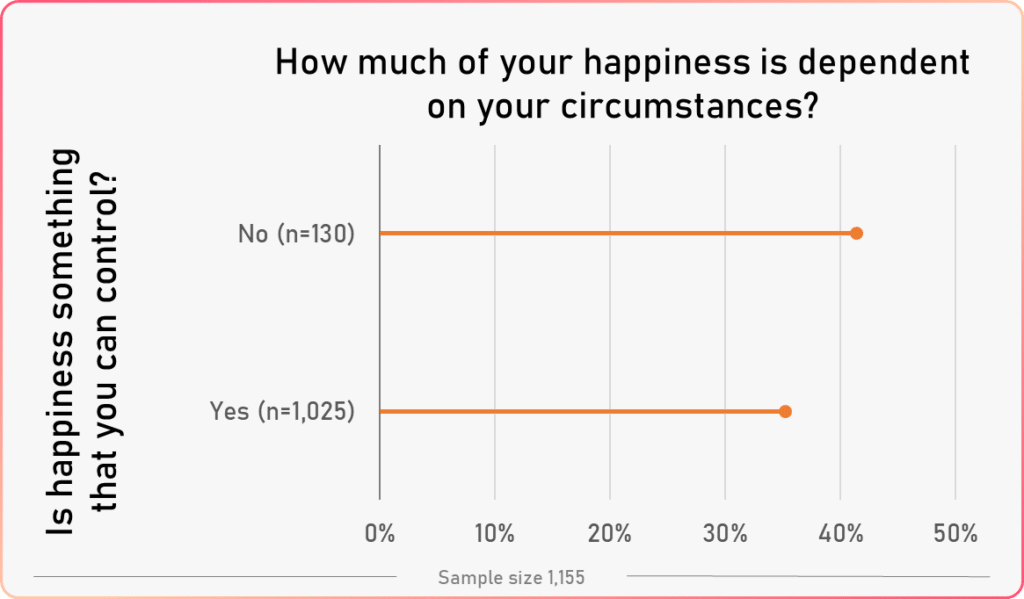
People who think happiness is controllable think that their happiness is 18% less circumstantial than people who think happiness is uncontrollable (41.4% vs 35.2%).
What this observation suggests is that people who believe happiness can be controlled have found ways to make their happiness less circumstantial. In other words, these people have founds ways to control their happiness more, so that a smaller part remains out of our control.
Gender
In general, both women and men are inclined to think that roughly 35% of our happiness is circumstantial:
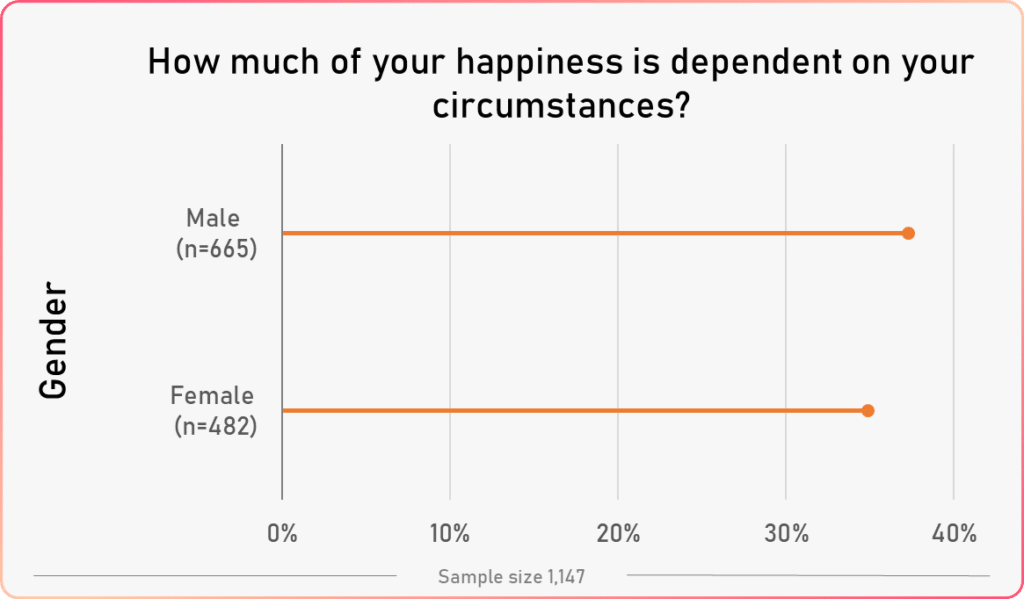
The difference between men and women is only 2% (35% for men vs 37% for women).
Age
The amount of our happiness that we think is dependent on our circumstances follows the well-known U-curve.
This is shown in the chart below:
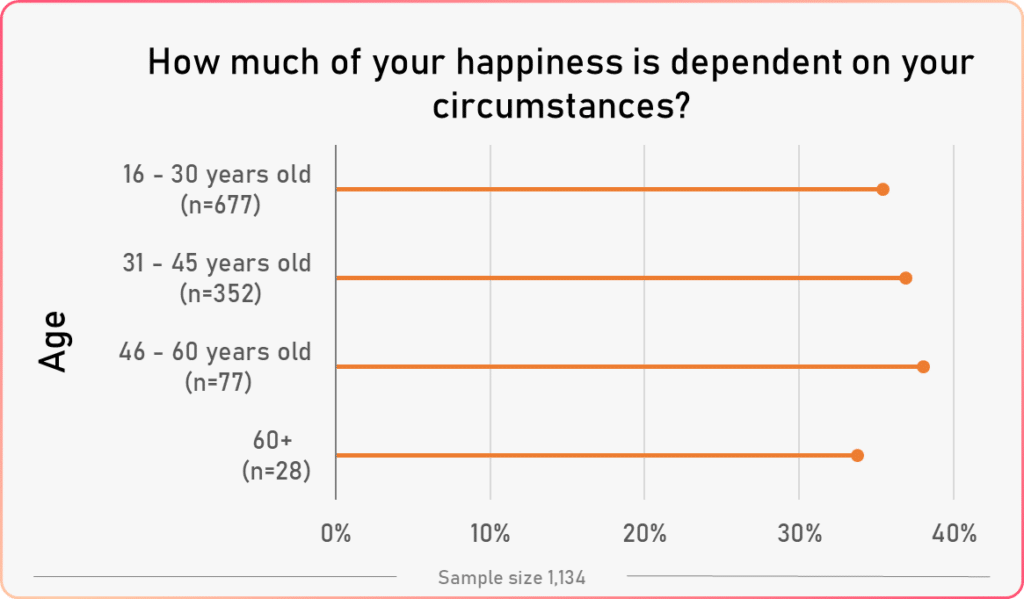
The average percentages per age group are as follows:
- 16 – 30 years old: 35.4%
- 31 – 45 years old: 36.9%
- 45 – 60 years old: 38.0%
- 60+ years old: 33.8%
The percentage of our happiness that is determined by external factors or circumstances increases as we age, and reaches a peak when we’re between 45 and 60 years old. From there, the influence of external circumstances on our happiness decreases again.
This finding corresponds with the well-researched U-curve in happiness. This article by Inc.com gives a good explanation of what this phenomenon is.
In general, happiness decreases from age 18 and reaches a peak unhappiness at approximately age 47. From there, the happiness levels gradually increase again.
Respondents between age 45 and 60 show the highest percentage of circumstantial happiness, which would correlate with a lower happiness rating. This result is similar to the U-curve of happiness that is observed around the world.
Education
High school graduates tend to feel like a bigger part of their happiness is circumstantial when compared to people with a Bachelor’s or Master’s degree.
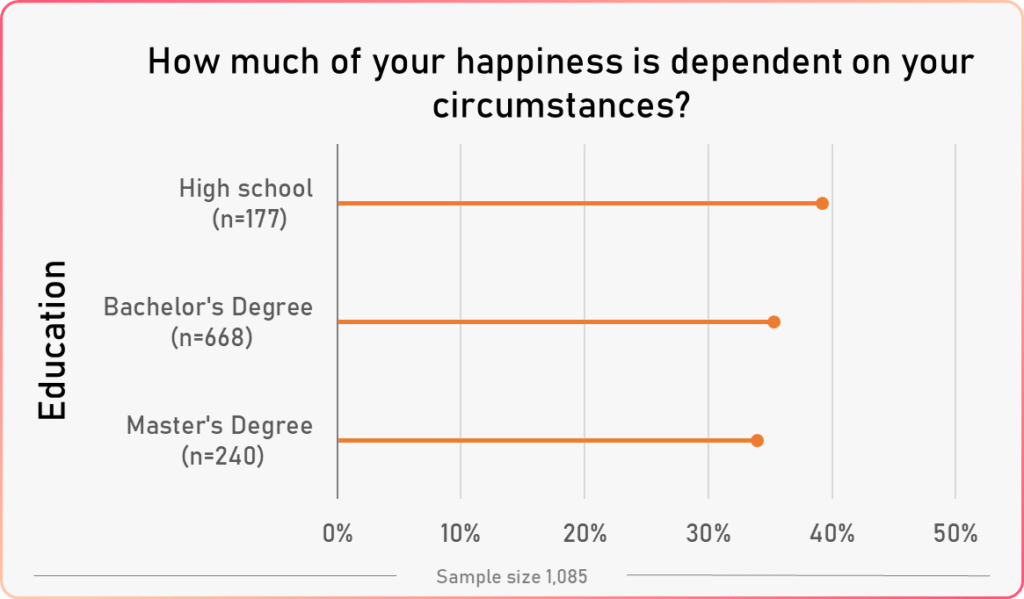
We surveyed the respondents about their educational background:
- What is the highest degree or level of education you have completed?
Answers showed a negative correlation between educational background and the amount of circumstantial happiness. In other words, a higher level of education predicts a lower percentage of happiness that is circumstantial, according to the respondents.
Respondents with a Master’s degree think that their happiness is 15% less circumstantial than high school graduates (39.2% vs 34.0%).
In another study article, we found that our level of education is positively correlated to the amount of control we feel over our happiness. This is in line with our observations. People who feel in control of their happiness also indicate that their happiness is less dependent on circumstances.
Marriage
Those who are unmarried tend to think that a bigger part of their happiness is circumstantial, according to the respondents.
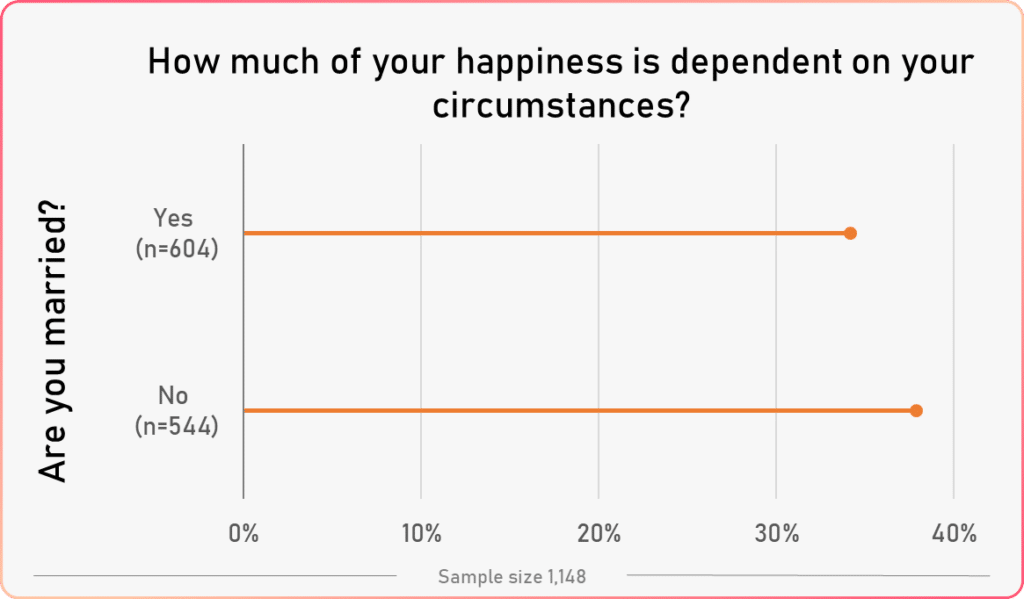
Married people think that 34.2% of their happiness is circumstantial, while unmarried people indicate that this percentage is 37.9%.
This is most definitely a good example of a correlation that doesn’t prove causation.
It’s more likely that married people are happier, and as a result, are more inclined to attribute a smaller part of their happiness to external circumstances.
In the words of Daniel Gilbert, psychology researcher and best-selling author:
Married people are happier than unmarried ones, perhaps because the single best predictor of human happiness is the quality of social relationships.
Daniel Gilbert
Employment status
Respondents were asked the following question:
What is your current employment status?
They were able to choose out of the following answers:
- Employed full-time (n=836)
- Employed part-time (n=138)
- Not employed (n=42)
- Retired (n=17)
- Seeking opportunities (n=48)
- Student (n=52)
- Prefer not to say (n=22)
Students feel like their happiness is most dependent on circumstances, compared to people with other employment statuses. On average, students feel like 40.9% of their happiness is circumstantial.
This is 14% higher than the 36% average of all 1,155 respondents. This 40.9% is also the same average percentage as the people who rated their happiness with a 3 on a scale from 1 to 10.
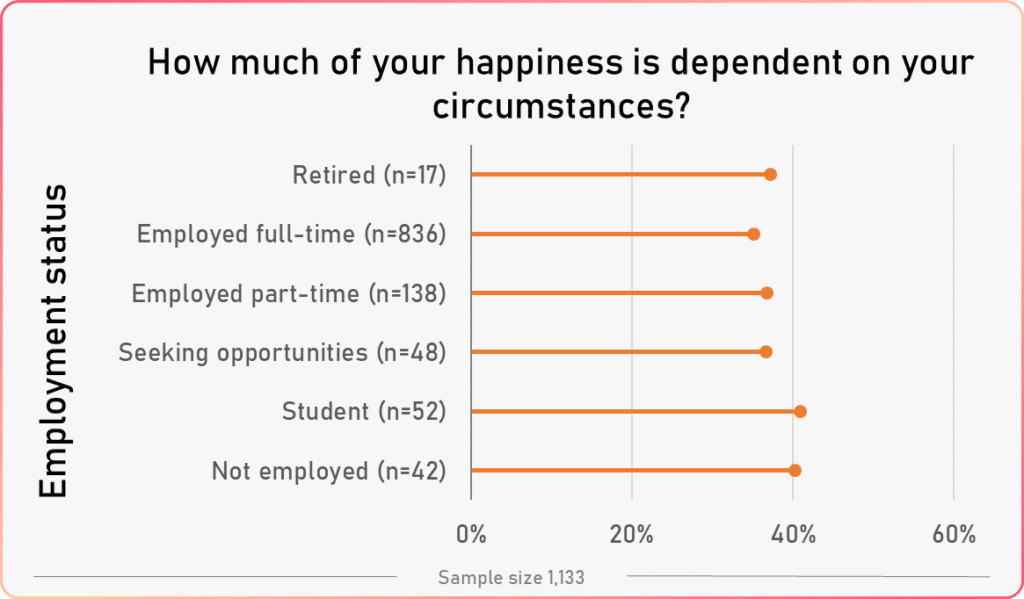
The answers suggest that between finishing college (student) and finding a job (employed), the percentage of your happiness that is circumstantial decreases from 40.9% to 35.2%.
Children
Having children did not seem to have a strong influence on the amount of circumstantial happiness, according to the responses.
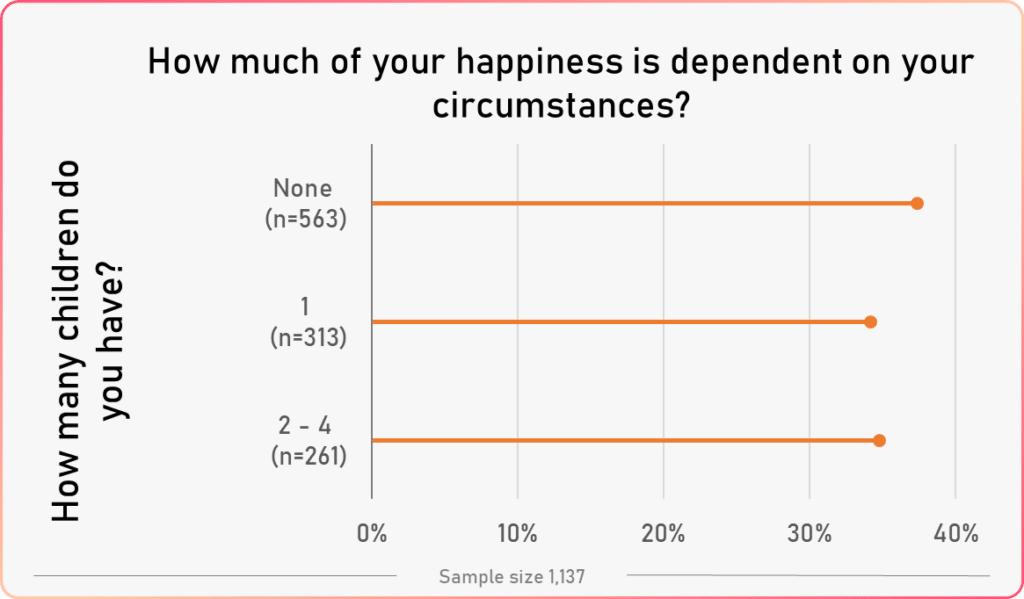
How does this fit the popular 50-40-10 rule of happiness?
Our study on the topic of circumstantial happiness contradicts the observation that was made in the 2005 paper ‘Pursuing Happiness: The Architecture of Sustainable Change‘.
This paper suggests that only 10% of our happiness is circumstantial.
2 years after this paper was published, the 50-40-10 rule of happiness became popular after the book ‘The How Of Happiness’ was released.
Our study amongst 1,155 respondents suggests that this 10% of circumstantial happiness is roughly 3,5x bigger in reality.
How was the 10% originally determined?
The 10% rule was determined in a paper which set out to find how much of the following factors influenced our happiness:
- Genetics
- Circumstances
- Internal state of mind
Genetics
There is a part of our happiness that is determined by our DNA. We can’t change this. Some people are simply more prone to be happy than others. This was studied by examining identical twins in 1996, where 44% to 52% of our well-being is associated with genetic variation.
In the 2005 paper, it was concluded that 50% of our happiness is determined by our genetics.
Circumstances
The difference between circumstances and our internal state of mind is that circumstances are things that happen to us. We can’t influence the things that happen around us, whereas we do have a certain amount of control over our own internal state of mind.
The 2005 paper states that 10% of our happiness is determined by circumstances. The 2005 paper refers to two separate papers from 1999, that state varying figures to account for circumstantial happiness ranging from 8% to 15%.
Upon investigation, the determination that 10% of our happiness is circumstantial is debatable. More details about this debate are included in this chapter.
Internal state of mind
With genetics and circumstances taking up respectively 50% and 10% of our happiness, that leaves as much as 40% of our happiness to our internal state of mind. Or in other words, we can influence 40% of our happiness with intentional actions.
These 3 factors combined form the 50-40-10 rule of happiness, which was made popular by the book ‘The How Of Happiness’.
Critiques of the 50-40-10 rule of happiness
The 50-40-10 rule has been critiqued recently in 2019, in a paper devoted to debunking the original 2005 paper. This is an interesting read for anyone who wants to get into detail on how the 2005 paper came to be.
What initiated this 2020 study?
What initiated us – the team behind Tracking Happiness – to conduct this study was in part caused by this criticism. Criticism usually leads to progress, growth and improvements, provided that the people providing criticism actually make an effort to think in solutions and provide a better alternative.
It’s relatively easy to criticize, but we wanted to provide a meaningful addition to the existing models.
So even though a lot can be said about the method and validity of this study, it does offer an alternative point of view on the 50-40-10 rule that we believe is meaningful and interesting.
We’ve released study results on all three aspects of the 50-40-10 rule:
- 40% of your happiness is determined by your internal state of mind.
- 36% of your happiness is circumstantial (as covered in this article).
- 24% of your happiness is genetic.
Methodology
If you’re looking for more information on how the study was performed, this article provides an overall introduction to this study. It also includes links to other result articles that are relevant to this study.
Want to know more details? Like who was surveyed, what are the demographics of the respondents, and how the study was performed? Here is a link to a document that explains it all (opens in a new window):
Closing words
Roughly 35% of our happiness is determined by external circumstances. This is 3.5x more than what was concluded in a 2005 study. Our new study suggests that a much bigger part of our happiness is circumstantial.
Does this study shed light on what type of people are inclined to think that happiness is circumstantial? What do you think of these results? Let us know in the comments below!
Tracking Happiness, 2020. How Much Of Our Happiness Is Circumstantial? (New Study Results!). [online] Tracking Happiness. Available at: https://www.trackinghappiness.com/circumstantial-happiness-study/

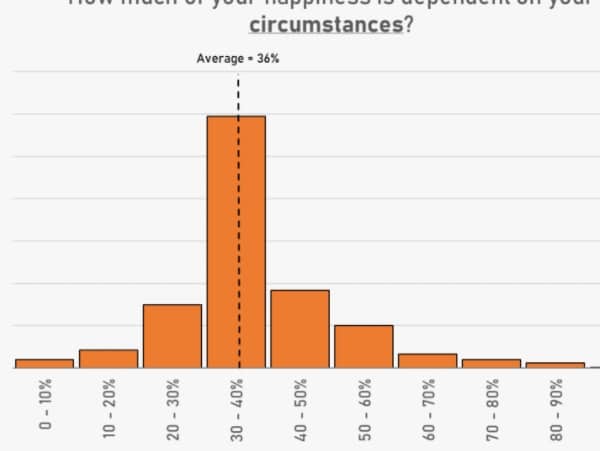
Hi there,
i came across your work a while back and i found it deeply interesting. and I’m just wondering if the last part “24% of your happiness is genetic” has been released yet?
i don’t seem to be able to find any links to it.
great and inspiring work!
Hi Sunny,
Thanks for the nice words. The study results of the happiness <> genetics can be found here:
https://www.trackinghappiness.com/how-much-happiness-is-genetic/
All the best,
Hugo